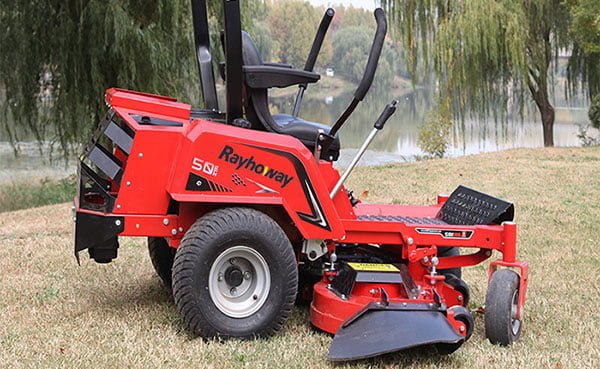Maintaining a well-manicured lawn often involves using a ride on mower, a convenient tool for large areas of grass. However, when it comes to slopes, the question of safety and effectiveness arises. This article explores the feasibility of using ride-on mowers on slopes, the risks involved, safety tips, and best practices for mowing hilly terrains.
Understanding Ride On Mower
Ride on mower, also known as riding lawn mower, is designed for efficiency and ease of use over large lawns. These mowers come in various types, including lawn tractors, garden tractors, and zero-turn mowers. Each type offers different features, but all share the common advantage of reducing physical effort and time spent on lawn care.
The Challenges of Mowing on Slopes
Slopes present unique challenges for ride on mower. The primary concerns are stability, traction, and control. Here’s a closer look at these challenges:
1. Stability Issues
Ride on mower is generally stable on flat ground, but slopes can significantly affect their balance. A steep incline can shift the mower’s center of gravity, making it prone to tipping over. This is particularly true for zero-turn mowers, which have a higher risk due to their design.
2. Traction Problems
Maintaining traction on a slope is another challenge. Wet or loose soil can cause the mower’s wheels to slip, reducing control and increasing the risk of sliding or tipping. Proper tire maintenance and the use of appropriate tires can help mitigate this issue.
3. Control Difficulties
Controlling a ride on mower on a slope requires skill and caution. Sharp turns, sudden stops, and changes in speed can all contribute to a loss of control. It’s essential to operate the mower smoothly and avoid abrupt maneuvers.

Safety Tips for Using Ride On Mower on Slope
Safety should always be the top priority when using a ride-on mower on a slope. Here are some essential safety tips to keep in mind:
1. Check the Slope Angle
Before mowing, measure the slope’s angle. Most ride-on mowers are safe to use on slopes with an incline of up to 15 degrees. For steeper slopes, consider using a push mower or other specialized equipment.
2. Mow Up and Down, Not Across
When mowing on a slope, always drive up and down rather than across. Mowing across a slope increases the risk of tipping. By moving up and down, you maintain better control and reduce the risk of the mower becoming unbalanced.
3. Adjust Speed Appropriately
Operate the mower at a slower speed when on a slope. This helps maintain control and allows you to react more effectively to changes in terrain. Avoid sudden acceleration or deceleration.
4. Use Proper Tires
Ensure your mower is equipped with tires suitable for slopes. Tires with good tread and proper inflation can significantly improve traction and stability.
5. Regular Maintenance
Regular maintenance is crucial for safe operation. Check the mower’s brakes, steering, and tires before each use. Ensure that all parts are in good working condition to prevent mechanical failures that could lead to accidents.
Best Practices for Mowing Slopes
In addition to safety tips, adopting best practices can enhance your mowing experience on slopes:
1. Start at the Bottom
Begin mowing at the bottom of the slope and work your way up. This method allows you to gradually adjust to the incline and maintain control.
2. Avoid Wet Conditions
Mowing on wet grass or soil can reduce traction and increase the risk of sliding. Wait for dry conditions to ensure better control and stability.
3. Use Counterweights
Some ride-on mowers allow for the addition of counterweights to improve stability. Consult your mower’s manual to see if this is an option and follow the manufacturer’s recommendations.
4. Stay Alert
Always stay alert and focused when mowing on a slope. Be aware of obstacles, holes, or uneven terrain that could cause the mower to tip or lose traction.
Alternatives to Ride-On Mowers for Slopes
For particularly steep or challenging slopes, ride-on mowers may not be the best option. Consider these alternatives:
1. Push Mowers
Push mowers, especially those with self-propelling features, can be safer and more manageable on steep slopes. They provide better control and reduce the risk of tipping.
2. Robotic Mowers
Robotic mowers are becoming increasingly popular for their ability to handle various terrains, including slopes. They can navigate and mow slopes without the risk of tipping over.
3. Professional Services
For very steep or large slopes, hiring professional landscaping services may be the safest and most efficient option. Professionals have the equipment and expertise to handle challenging terrains.
Conclusion
Using a ride-on mower on a slope is possible, but it requires caution, skill, and adherence to safety guidelines. By understanding the challenges, implementing safety measures, and following best practices, you can effectively and safely maintain sloped lawns. Always assess the slope’s angle, use appropriate equipment, and consider alternatives if the slope is too steep for safe mowing. With the right approach, you can keep your lawn looking pristine without compromising safety.
Please leave a message if there is anything confused or visit official website of ride on mower if you are interested in.